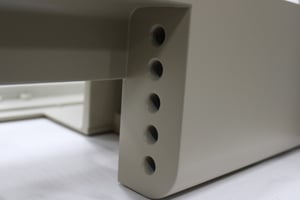Elastomeric Polyurethanes
What are Elastomeric Polyurethanes?
Elastomeric polyurethanes are derived from a chemical reaction between a polyol and isocyanate, making this a true thermoset polymer. Commonly associated with Reaction Injection Molding (RIM), elastomeric polyurethanes offer designers the ability to produce a wide range of robust yet adaptable products and components. Because of their elastic nature, elastomeric polyurethanes are best used for moving applications where superior load-bearing, abrasion, and impact resistance are important. For additional information on elastomeric polyurethanes and other common RIM materials available for your product design, click here.
Elastomeric Polyurethanes Compared to Structural Foams
Despite having many similarities, elastomeric RIM polyurethanes and structural polyurethane foams display different properties. For starters, structural foams are formed through a unique foaming process in which creates a dual-layer composition. This structure, similar to a hardboiled egg features a foamed inner core surrounded by a solid outer shell or “skin”. For this reason, structural foams are typically known for being extremely lightweight when compared to elastomeric polyurethanes. While both materials exhibit superior properties over injection-molded plastics, such as ABS or polyethylene, elastomeric polyurethanes can exhibit far greater tensile strength in high-stress environments. The primary use for structural foams is housings or cabinetries for high-end electronics or medical device equipment.
How to Use Elastomeric Polyurethanes in Your Product Design

Elastomeric RIM polyurethanes employ a similar design process as structural foams, so the same 5 design tips discussed, here, still apply! However, it is important to consider if weight is critical to your application when designing with elastomeric polyurethanes. Since this material is naturally denser compared to structural foams, molded parts are noticeably heavier. To resolve this, simply modify your design's wall thickness, and incorporate the same draft and radii throughout. By doing this, you could reduce the weight, lower per piece price, and overall improve performance.
Conclusion
If your application requires improved abrasion, impact, and tear resistance, elastomeric RIM polyurethanes can be an excellent substitute for structural foams. To further explore if elastomeric polyurethanes are a good fit for your RIM product design, complete our design tool, here, or download our Durethane® R material data sheet below:





